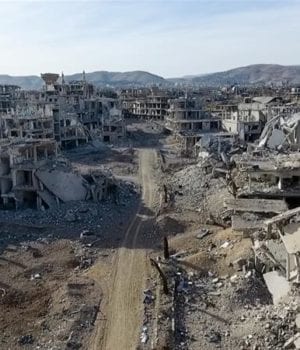Eastern Ghouta: At least 42 killed amid ongoing offensive – By Aljazeera newsroom (Aljazeera.com) / March 12 2018

At least 42 people have been killed in Syria’s Eastern Ghouta as government forces continue to launch air raids on the rebel-held enclave while edging closer to its central towns.
Activists in Douma, one of the main urban centres, told Al Jazeera on Sunday that Syrian jets have “not stopped bombing towns all over Ghouta”.
Syrian state television reported the town of Mudeira had been seized on Sunday by the army, which was now able to link up with units on the other side of Eastern Ghouta.
Government forces have now surrounded Douma after capturing the neighbouring town of Mesraba, 10km east of Damascus, on Saturday, it said.
The advance on Mudeira has driven a wedge deep inside the rebel-held territory, leaving Douma and Harasta cut off.
Civilians trapped
The UN estimates there are 400,000 civilians trapped in Eastern Ghouta.
Activist Nour Adam said eight people died in Jobar, a town east of the capital Damascus, and 16 people from the same family were killed in an attack on Douma.
The rest died in attacks that hit the towns of Harasta, Zamalka, and Irbin, Adam said.
On Saturday, the Syrian Observatory for Human Rights, a UK-based war monitor, told Al Jazeera that Eastern Ghouta had been divided into three – Douma and its surroundings; Harasta in the west; and the rest of the towns further south.
The government’s latest offensive on Eastern Ghouta, which began on February 18, has killed 1,099 civilians over the past 21 days, the Syrian Observatory reported.
The figure includes 227 children and 145 women, while at least 4,378 others have been wounded.
The Syrian Civil Defence, a volunteer rescue group also known as the White Helmets, said on Sunday a government attack on Irbin a day earlier involved “chlorine … phosphorus”. It was the second alleged chemical attack to hit the suburb in a matter of days.
The government denies using either incendiary weapons or chlorine gas bombs and said on Saturday it had information the rebels were planning to stage a fake chemical attack to discredit the army.
Previous pattern
The Syrian government’s offensive follows a pattern of previous assaults on opposition strongholds, deploying massive air power and tight sieges to force rebel fighters to accept “evacuation” deals.
These involve rebels surrendering territory in exchange for safe passage to opposition areas in northwest Syria, along with their families and other civilians who do not want to come back under Assad’s rule.
Al Jazeera’s Alan Fisher, reporting from Gaziantep along the border in neighbouring Turkey, said Russian-backed Syrian forces tend to use military gains to try and secure a “political advantage”.
“[They do so] by saying to fighters maybe you should move to another part of Syria,” Fisher said.
On Friday, a number of rebel fighters and their families were evacuated from Eastern Ghouta, state media reported.
These include rebels from Jaish al-Islam, one of the main opposition groups in the enclave, which announced it had agreed to the evacuation of several Hay’et Tahrir al-Sham fighters – previously part of al-Qaeda-linked al-Nusra Front – who were detained by the group.
Wael Olwan, spokesman of the rebel group Failaq al-Rahman, with ties to the Free Syrian Army, denied on Sunday that such negotiations were taking place – despite the government’s claims that talks with rebel groups were under way.
Suffocating siege
The Damascus suburb of Eastern Ghouta has been under the control of armed opposition groups since 2013 – two years after a popular uprising called for the removal of President Bashar al-Assad.
The area has been under a suffocating siege by government forces since then in an attempt to drive out rebels.
The ongoing fighting on multiple fronts, coupled with continuous shelling and air raids, has prevented desperately needed food and medical supplies from being delivered to residents trapped inside.



















